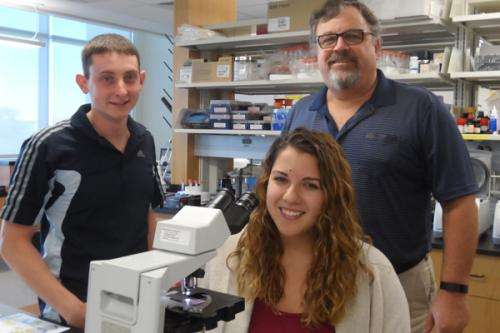New compounds more potent in combatting brain-eating amoeba's fatal infection

A University of South Florida Health College of Public Health professor and his team of researchers have zeroed in on compounds that could one day lead to fast-acting treatments for the fatal infection caused by the brain-eating amoeba known as Naegleria fowleri.
In a study published online this month in the journal Antimicrobial Agents and Chemotherapy, Dr. Dennis Kyle and his fellow researchers show that the two new compounds they identified were 500 times more potent than drugs currently used to combat the amoeba's fatal infection.
Naegleria fowleri, a free-living amoeba (or FLA) commonly found in warm freshwater lakes, ponds and rivers, hot springs, and poorly chlorinated pools, causes primary amoebic meningoencephalitis, or PAM. PAM is a disease that though rare, is almost always deadly. With a 97 percent fatality rate, the disease usually affects summertime swimmers or Neti pot users who get contaminated water up their noses. (They cannot get PAM by swallowing or digesting contaminated water because stomach acid kills the amoeba.)
Once in the nose, the amoeba quickly moves to the brain, where the resultant infection destroys brain tissue, often leaves afflicted patients comatose within days and usually kills them in a little more than a week. Of 132 reported cases in the United States through 2013, only three survived, according to the Centers for Disease Control and Prevention. The most recent U.S. death was that of a 9-year-old Kansas girl, an avid water skier who died last summer from PAM after swimming in several area lakes.
Despite PAM's dire prognosis, its rarity has made it an "orphan disease" – with no concerted efforts to discover new drugs to treat people affected by it, said Dr. Kyle, a professor of global health in the USF College of Public Health.
"One of the major problems is that there have been few people working on it," he added.
Dr. Kyle had studied Naegleria fowleri as a Ph.D. student. In the decades that followed, his expertise and specialization took him elsewhere into antimalarial drug research and to prominent national and international positions – including as deputy director of the Division of Experimental Therapeutics for the U.S. Army's Drug and Vaccine Development Programs; and also as the chair of the Genomics and Discovery Research Steering Committee and the Compound Evaluation Network for the World Health Organization.
During those years, he kept up with findings related to the amoeba. He became perplexed as to why modern drug discovery methods were not being applied to this organism.

In this study, Dr. Kyle did just that, assisted by a team of researchers that included Dr. David Boykin from Georgia State University, who worked closely with Dr. Kyle and was the lead on medicinal chemistry aspects of the project.
The study – which was supported by a grant from the National Institute of Allergy and Infectious Diseases – outlines how they developed for the first time the screening tools used to identify chemical compounds with the potential to treat the disease.
Up to this point, drugs used against PAM – including Amphoterecin B, pentamidine, propamidine, anticancer miltefosine and azoles – were developed to tackle other diseases but were also found to have a limited impact on the amoeba. Yet no large-scale drug screening program existed to address it head-on.
"In this study, we aimed to develop a discovery paradigm to identify, evaluate, optimize, and advance new molecules towards the clinic for use as new therapies for pathogenic FLA," the researchers wrote in the study's report.
A new 72-hour assay or measurement format they developed revealed the lack of potency and slow onset of most drugs currently used against the amoeba. In a major breakthrough, the new format and tools instead helped them discover compounds with 500 times the potency and ways to isolate compounds that take action far faster than current treatments.
Given the deadly speed of the amoeba's destruction, this last part becomes essential, Dr. Kyle said.
"We really need a new drug that acts quickly," Dr. Kyle added.
To be sure, Dr. Kyle does not anticipate the studies' findings to one day supplant current therapy or treatment for PAM, but rather to enhance and complement it.
Also, the research appears promising for future treatment against other types of related amoebae not connected to PAM, such as the one that causes Acanthamoeba keratitis, a serious eye infection that can result in visual impairment or blindness.
Still, more research is needed before new drugs hit the market, Dr. Kyle stressed. That includes more testing of compounds to make sure they cross the blood-brain barrier, the testing on genetic mouse models and clinical trials before seeking Food and Drug Administration approval.
"There is work to do," he said. The end goal is to save more lives.
"That's certainly our hope," he said, "to reduce the fatalities."
More information: "Bis-benzimidazole hits against Naegleria fowleri discovered with new high throughput screens" Antimicrob. Agents Chemother. AAC.05122-14; Accepted manuscript posted online 20 January 2015, DOI: 10.1128/AAC.05122-14















